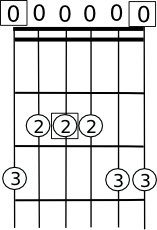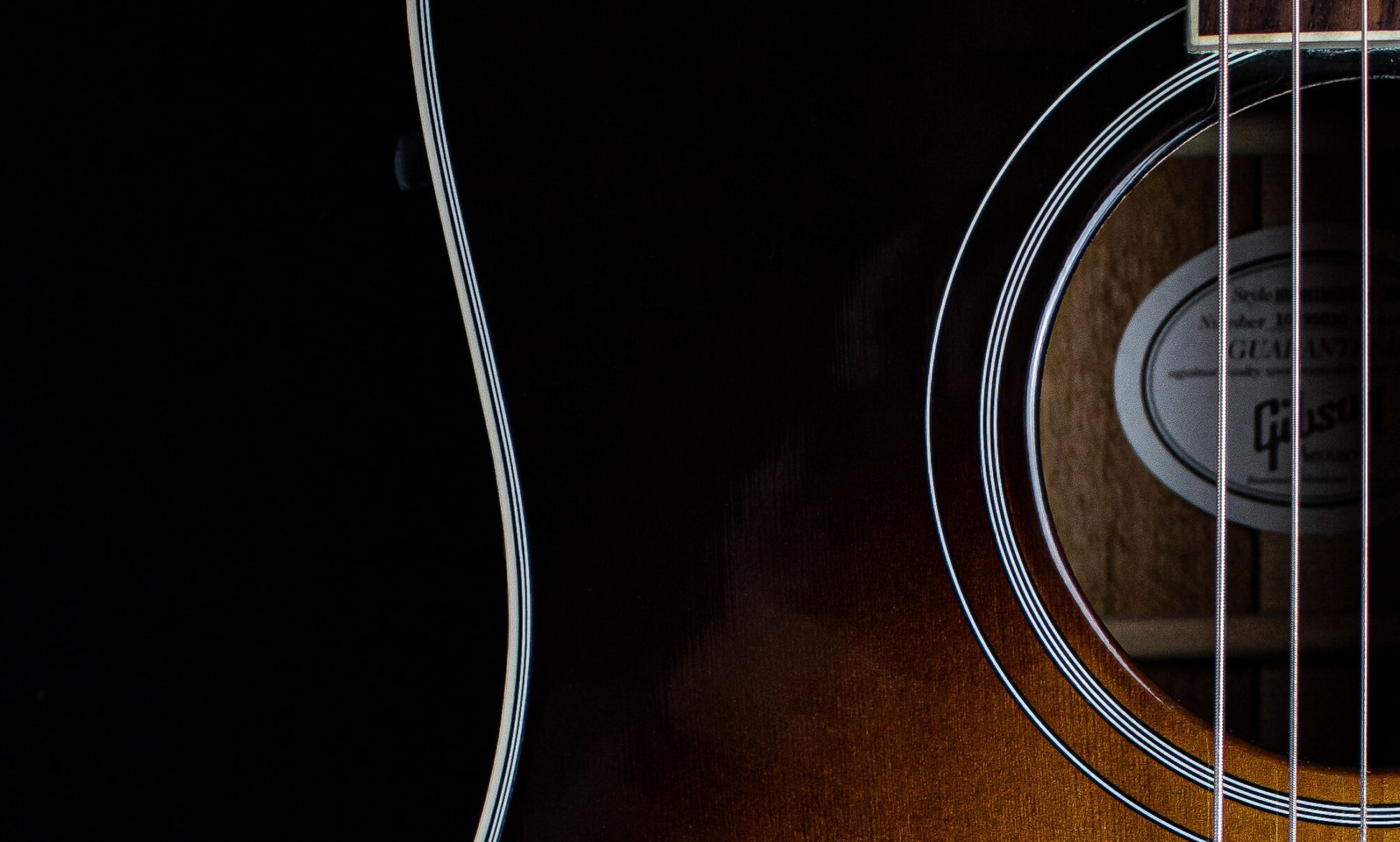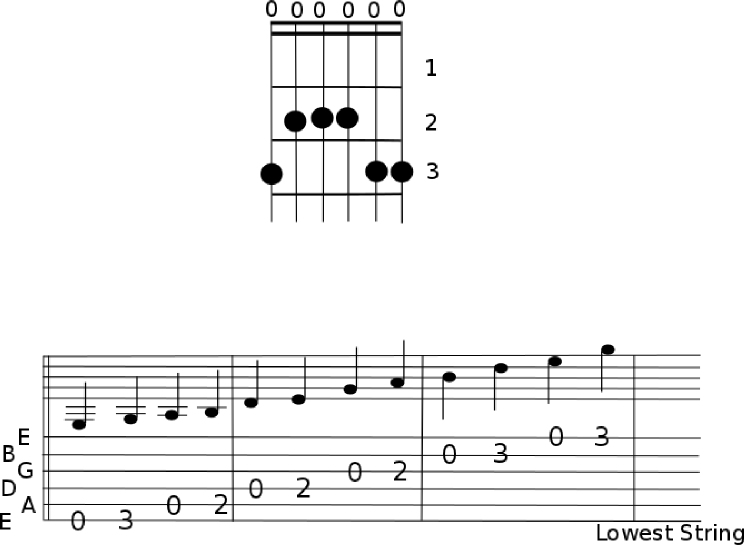Here is a practice track for working on your E major soloing. It is two chords, a I-IV progression – E and A in the key of E major.
Practice Track – E minor Pentatonic
Here is another practice track for beginning guitarists wanting to sharpen up their E minor pentatonic scale! It is a 16 bar pattern:
|Em | | | |
|Am | | | |
|Em | | | |
|B | | | : ||
It is at a pretty slow pace, around 55bpm, so you can relax and concentrate on getting the right notes sounding good. In case you need a reminder, here is the E minor pentatonic scale in open position:
Rock Practice Track – A
Here is a rock practice track in the key of A. The chords are A, C, D and E – all power chords comprising the root and fifth. It is done at a slowish 100bpm, so you should have plenty of time to pick up what’s happening. See if you can work out which chords are where using your ear! The note G on the bottom string is used as a bend in between A chords and E chords – a standard rock and roll move!
Am Pentatonic Rock Practice Track
Practice your improvising using the A minor pentatonic scale, with the addition of a B on the E chords!
Enjoy,
Rob
Practice Track: Waves of the Danube
This is a practice track for beginning to intermediate guitarists and bass players! The Waves of the Danube was also recorded as “Anniversary Song” and appears under that name in the recordings of jazz guitarist Django Reinhardt. This track is at a very slow 90 bpm, so beginning and intermediate players can work the changes with plenty of time to get their arpeggios working! In Gypsy Jazz circles, it is played much more quickly, but you have to practice slow in order to play quick! Enjoy!
Practice Track for Bassists: D Dorian.
This is a practice track for beginning and intermediate bassists. It is a simple slow rock rhythm track, with drums and two rhythm guitars. The chords are D minor and G:
||: Dm | |G | : ||
Start by using the root notes of each chord, and play on beat one of each bar. See if you can add to the groove with where you put your notes – listen in particular to the bass drum, and see if you can synchronize with it.
When you are comfortable with this, add the fifths of each chord (A for the D minor, and D for the G).
Then see if you can incorporate the thirds of each chord ( F for D minor and B for G).
For walking bass lines and riffs, experiment with the D minor pentatonic scale, and the Dorian mode of the C major scale.
Enjoy!
Practice Track: E minor Pentatonic
One of the most important scales to learn for guitarists interested in rock and blues is the minor pentatonic scale. To help you polish up your licks using the E minor pentatonic scale, here is a practice track in a rock style to help you out. Here is the scale in first position: numbers indicate the fingers to use, and the squares show where the “E’s” are.
 When you have memorised the scale, fire up the following practice track and see if you can play along!
When you have memorised the scale, fire up the following practice track and see if you can play along!
Practice Track: G major – Folk Rock
Here is a practice track in a folk rock style, based on the chords to “Knockin’ on Heaven’s Door”, a perennial guitar favorite – mainly because the chords are very easy:
||:G | D |C | |G |D |Am |Am : ||
To solo over these chords the best place to start is in the key of G major, as all the chords contain only notes from that key. So get the G major scale under your fingers, and make use of the following track to hone your improvising skills!
Practice track for Bassists
This is a practice track for beginning and intermediate bass players who are interested in playing jazz styles. I have taken the following four chords:
||:Am7 |D7 |Gmaj7 |Cmaj7 : ||
which are the chords ii V I IV in the key of G major.
These chords are common in many jazz style progressions, and can be found, for example, in the first four bars of Autumn Leaves. To construct a bass line over these chords, take the following steps.
(1) First have the G major scale under your fingers. You can use the open position, or any moveable scale shapes that you know.
(2) Play through the progression playing the tonic of each chord on beat one of each bar.
This very simple bass line is the foundation upon which many things can be built. To this we can add a note leading into each new chord.
(3) On beat 4 of each bar play the note of the G major scale below the note of the chord root you are about to change to. For example on beat 4 of the Am7 bar, play a C, the note below D.
(4) On beat 4 of each bar, we can also play the note above the chord root we are heading for:
 (5) Once you are familiar with both of these, you can mix them up, leading into some notes from below, other notes from above.
(5) Once you are familiar with both of these, you can mix them up, leading into some notes from below, other notes from above.
This technique makes for a strong bass line, particularly when going around the cycle of fourths, as in the progression above. One reason is that the diatonic (i.e. from the major scale) leading note is either the fifth or the third of the current chord in the above progression. The only exception is the change from Cmaj7 to Am7 in point (4).
(6) Now try combining two leading notes on beats 3 and 4:

(7) To play a simple walking bass line, simply add scale notes in between in pitch, between the other notes, making sure that the note on beat 4 always leads into the next chord:
The above are only my examples – there are a great many variations on bass lines you can create using this simple technique – and they will all sound great over these chords and over many other jazz style progressions. Using this technique you can play something different on every run through the chords, but always strongly working the changes. That’s one way you can create interest and dynamism in the music!
This is only one “concept” for constructing bass lines, and you will need to develop a selection of such approaches. As you gain experience in listening and playing, your ear will tell you more and more what will sound good in any given situation.
And here is the practice track to try these techniques with – for best results, get completely comfortable with each step before going on to the next!
If you find that the chords are changing too fast for you, try the following track, which has the same four chords, but each chord goes for two bars:
Autumn Leaves First 4 Bars – 2 bars per chord
Enjoy!
C major Practice Track: C & G7
This is a simple practice track for beginning guitarists. The drums provide a basic rock beat behind a simple bass line and open position chords. The chords are C and G7:
||: C | |G7 | : ||
Use it to practice making up a melody (improvising!) using the notes of the C major scale. Listen carefully for which notes go better with each chord.
Have Fun!
C major practice track
Here is a simple practice track for practicing improvising in a C major scale. The chords are
|G |Am |Bm7b5 |C : ||
It is suitable for any player who can play the C major scale! When you are playing, see if you can listen to each note, and pick out notes which go with the chords.
C major practice track: V-vi-vii-I
Playing the guitar is about making the most of what skills and techniques you have, being musical with the things that you CAN do. Don’t worry about things you can’t do – just focus on what you can do, and be as musical as you can. The more you play, the range of things you can do increases – especially if you have a good regular practice routine.
As an example, here is a melody part for the same progression played entirely in first position, using only one octave from the G string up to G on the top E string:
C major practice track with lead (melody):
So be as musical as you can with the skills and technique you have. It is a good habit that will strengthen your playing as you continue to improve your technique and skill level. And don’t forget to have fun!



